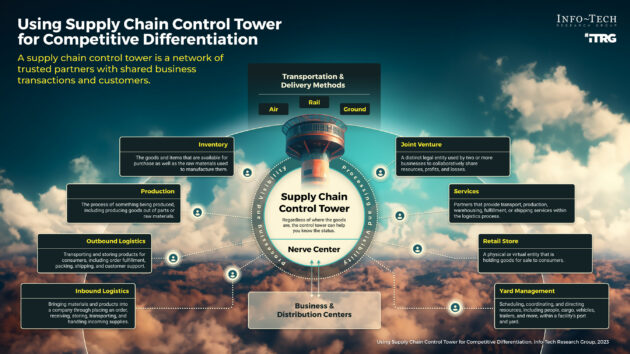
Modern control towers may be the solution to supply chain woes, says Info-Tech Research Group
by CM staff
Geopolitical activities are causing economic action to be reallocated around the world, leading to new supply chain challenges beyond those felt during COVID-19.

Photo: CNW Group/Info-Tech Research Group.
TORONTO — With a renewed rise in the industry’s focus on supply chain management, Info-Tech Research Group has released a research-based blueprint to help operations leaders and chief information officers (CIOs) implement a supply chain control tower to alleviate uncertainty and mitigate risk.
In Using Supply Chain Control Tower for Competitive Differentiation, the IT research and advisory firm explains that a supply chain control tower (SCCT) is a similar concept to an airport control tower. It is a central hub of people, processes, data coupled with visualizations, and analytics technologies that capture and process supply chain data for short- and long-term decision-making.
“The goal of a supply chain control tower is to capture real-time integrated supply chain data from across all touchpoints to enable enhanced visibility,” said Kevin Tucker, principal research director of manufacturing research at Info-Tech Research Group. “That visibility can then be utilized to optimize the supply chain through improved collaboration and information for making informed decisions. The primary goal is to make all points in the supply chain environment visible to the enterprise.”
The most comprehensive supply chain control towers use advanced capabilities, such as analytics tools, real-time data, and telescopic digital twins, that enable an organization’s ability to simulate the entire internal and external supply chain process. The firm further clarifies in the blueprint that adopting a capability-based approach that considers a holistically interconnected environment for end-to-end visibility of the supply chain is an integral part of addressing supply chain challenges in the future.
“A modern supply chain control tower answers the call as a central hub of information that acts as an overarching view into and across an organization’s supply chain. It will consider the current state of the supply chain, infrastructure, and the financials across the entire global supply chain network,” adds Tucker.
As there are several kinds of supply chain control towers to consider, Info-Tech Research Group has identified four phases that operations leaders and CIOs should expect from an SCCT, as outlined below:
Detect: Phase one includes strategic and operational signals, from sourcing to delivery, whereby real-time and near real-time decisions and actions need to be taken. Priorities that enact the correct level of urgency are defined in this phase.
Diagnose: The second phase requires a root cause analysis to determine the impact on revenue and service level agreements. It is additionally important to consider the probability of occurrence and the overall short- and long-term supply chain impacts.
Respond: Phase three offers scenarios and simulations that can be considered against benchmarks to identify solutions. The goal of this phase is to implement and integrate solutions and understand the triggers that cause issues to occur.
Learn: The fourth and final phase advocates that continuous improvement is the cornerstone of a well-designed control tower. Data integration and supply channel collaboration are vital for ensuring insight-driven decision-making.